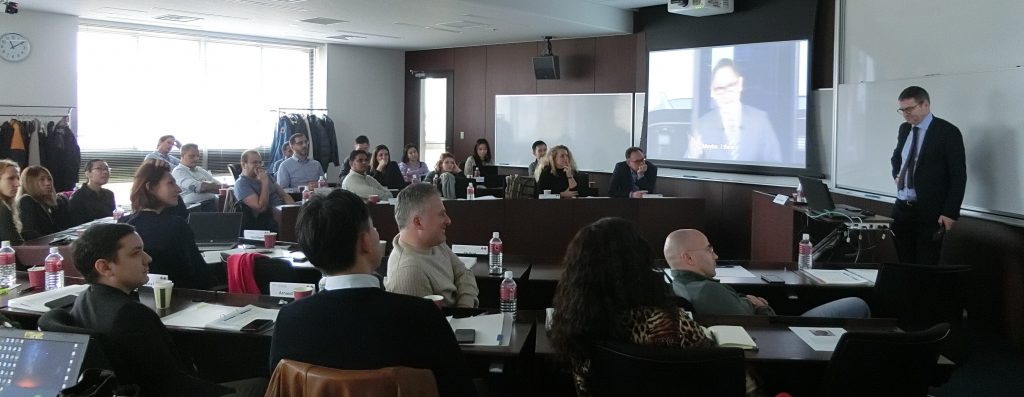A few weeks ago I gave a lecture at Waseda University to E-MBA students of ESSEC and Mannheim University of three different campuses (Germany, Singapore and France) on transformation in Japanese corporations. It was following a class I did a few years ago, on The Third Road of Management or how to transform companies. The content of the class was based on my past experiences of executive at Nissan and Toyota, during their time of recovery in the year 2000 and 2010, and my analysis of the “once in a century” revolution in mobility that the world is going to experience in the coming decade. How Japanese carmakers are ready for this revolution and Japanese corporations for disruption in general? This was the theme of the lecture.
During the class, we studied how Japanese and western companies differ. Based on examples and academic literature, we explained with analogies (the gardener vs the architect or Tokyo vs Paris) the difference between a Japanese high context, bottom up culture where vision and harmony are key and more structured top down strategic and apparently rational approach as taught in MBA’s. However, in reality if both have their strengths neither is ideal.
We then went through Nissan recovery in the early 2000’s analyzing its internal mid-term process, how the Alliance with Renault worked and how, together with regions, it succeeded to imagine and develop a lineup of successful products that fed its growth during 10 years. It always relied on the collaborative strength of local organizations and a mixed bottom-up/top down process. Likewise, when Toyota went through an unprecedented quality and recall crisis in 2010, its CEO, Akio Toyoda decided to empower regions to fix defects; and it worked beyond expectations. During the same period, in Europe, local management decided to bet on its global technical differentiation, hybrid technology, at a time when diesel was at its peak, for its future growth. This bet, locally decided though based on a global strategic vision, proved successful and other regions replicated it. Finally, I explained how marketing of all regions decided together with HQ functions –from design to marketing-, not instructed by HQ, to build their common brand and marketing journey .
In both companies, a unique approach combining collectively bought-in or even built strategic direction and freedom of implementation proved successful. In short they built those successes on the combination of Japanese and western management principles.
We then looked back at Nissan and Toyota history. Even though the two companies were founded in the same period, in the 1930’s, their histories are very different. Toyota was the story of Kiichiro Toyoda’s vision that the 20th century was going to be the one of automotive industry. After his father Sakichi, invented the automatic loom, Kiichiro decided to create his own car, and learned by himself, improving permanently. Throughout the years, the company kept the philosophy of the origin, continuous improvement, just in time and automation with human supervision. Its growth was mainly organic and it always kept the name and the spirit of the founding family. Nissan (Contraction of Nippon Sangyou, 日本産業 meaning Japan Industries) was a completely different story of an industrial and financial holding, created by Yoshisuke Aikawa combining electric, mining, chemical and financial companies among others. It took over the carmaker DAT (hence Datsun name) and started by building Austin vehicles under license. The conglomerate was dismantled after WWII as many “zaibatsus”. Nissan’s history was made of merges and external growth. In 1966, the fusion with Prince, the maker of Skyline was an important step. Skyline became later an iconic car for Nissan. The company decided to drop Datsun brand to unify with Nissan, already used for domestic sales in the 1980’s. After escaping bankruptcy, it entered a strategic alliance with Renault in 1999 and then integrated Mitsubishi Motors. Having worked for Nissan and Toyota, I could feel how the history influenced the current behaviors and attitudes and finally choices.
We then reviewed the challenges to come of the automotive industry. Because of technical, environmental and societal deep changes, the industry is moving from a planned heavy mass-manufacturing industry to a more agile mobility service one. It will require quick decisions made at local level to serve the various needs of people, service and goods mobility. Eventually it will become necessary for mobility players to design and optimize the vehicles themselves to serve those new services and mobility experiences. We will move from “one size fits all” type of similar cars to an increased variety of objects of all forms and functions.
Finally, we debated on the challenges and roads that both companies are taking.
Akio Toyoda decided to create spinoffs of main TMC in such areas as data based mobility services, AI serving autonomous drive and new materials. He clearly stated that by doing so, he prepares Toyota to a new century as his grandfather did 70 years ago. He opens the company to partnerships. After a difficult year, the new management of Nissan is reaffirming its commitment to the Alliance with Renault and Mitsubishi. It also decided to move towards the new CASE (Connected, Autonomous, Shared and Electric) mobility economy.
We then had a very rich exchange with students with three main considerations:
- Are Toyota and Nissan are finally converging from different starting points?
- In this disrupted world, is the recipe to success to give much more freedom in a strategic frame?
- In this context, are Japanese firm in a favorable condition considering their strong bottom-up locally anchored organization and culture based on harmony?
Those are open questions but I felt all participants left with a high level of confidence that Japanese corporations, if they embrace the change and strategic challenges, have the resources and characteristics to succeed

